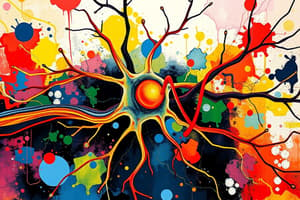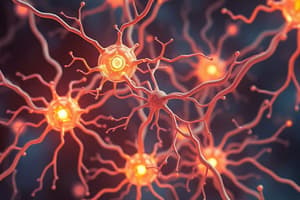Podcast
Questions and Answers
What effect can activating a single neuron have on decision making?
What effect can activating a single neuron have on decision making?
- It can bias decision making. (correct)
- It has no effect on decision making.
- It improves decision-making accuracy.
- It causes immediate electrical paralysis.
What is the role of dendrites in a neuron?
What is the role of dendrites in a neuron?
- To receive input from other neurons (correct)
- To transmit action potentials
- To process inputs
- To generate new neurons
How are action potentials generated in neurons?
How are action potentials generated in neurons?
- When input exceeds an intrinsic threshold. (correct)
- Through continuous stimulation from surrounding neurons.
- By constant ion flow through the axon.
- Through the accumulation of neurotransmitters.
What characterizes an action potential?
What characterizes an action potential?
What factor primarily carries information in an action potential?
What factor primarily carries information in an action potential?
What initiates the changes in membrane potential that lead to an action potential?
What initiates the changes in membrane potential that lead to an action potential?
When was the action potential first discovered?
When was the action potential first discovered?
Why was the mechanism of action potentials not fully understood for over 100 years?
Why was the mechanism of action potentials not fully understood for over 100 years?
What is the typical resting membrane potential of a cell?
What is the typical resting membrane potential of a cell?
What triggers the configurational change in ion channel structure?
What triggers the configurational change in ion channel structure?
According to Bernstein's hypothesis, what primarily causes an action potential?
According to Bernstein's hypothesis, what primarily causes an action potential?
What happens to ion movement when ions can move freely across the cell membrane?
What happens to ion movement when ions can move freely across the cell membrane?
How does the semi-permeable cell membrane affect ion movement?
How does the semi-permeable cell membrane affect ion movement?
What was a significant problem with Bernstein's hypothesis as shown by subsequent experiments?
What was a significant problem with Bernstein's hypothesis as shown by subsequent experiments?
What role do ion channels play in cellular processes?
What role do ion channels play in cellular processes?
Which ions are mentioned as being relevant to the membrane potential in the content?
Which ions are mentioned as being relevant to the membrane potential in the content?
What does the capacitance in the integrate-and-fire model represent?
What does the capacitance in the integrate-and-fire model represent?
What is represented by the equation dV(t)/dt = I(t) / C?
What is represented by the equation dV(t)/dt = I(t) / C?
What does 'I(t)' symbolize in the context of the integrate-and-fire model?
What does 'I(t)' symbolize in the context of the integrate-and-fire model?
In the integrate-and-fire model, what does the slope of the voltage over time indicate?
In the integrate-and-fire model, what does the slope of the voltage over time indicate?
Why does the integrate-and-fire model ignore the action potential generating mechanism?
Why does the integrate-and-fire model ignore the action potential generating mechanism?
What does the term 'phenomenological model' imply in the context of the integrate-and-fire model?
What does the term 'phenomenological model' imply in the context of the integrate-and-fire model?
What effect does injecting a square wave of current have on the neuron?
What effect does injecting a square wave of current have on the neuron?
What is the primary calculation that can be performed using the differential equation derived from the integrate-and-fire model?
What is the primary calculation that can be performed using the differential equation derived from the integrate-and-fire model?
What happens to the voltage when a positive current is injected into the neuron according to the integrate-and-fire model?
What happens to the voltage when a positive current is injected into the neuron according to the integrate-and-fire model?
Which factor is central to the behavior described by the integrate-and-fire model?
Which factor is central to the behavior described by the integrate-and-fire model?
What does the voltage function V(t) illustrate in the integrate-and-fire model?
What does the voltage function V(t) illustrate in the integrate-and-fire model?
The term 'current' in the context of the cell membrane refers to what?
The term 'current' in the context of the cell membrane refers to what?
In the context of the integrate-and-fire model, what does 'V(t+dt)' represent?
In the context of the integrate-and-fire model, what does 'V(t+dt)' represent?
How does the integrate-and-fire model simplify the study of neuron activity?
How does the integrate-and-fire model simplify the study of neuron activity?
What is the purpose of injecting a square wave of current into the neuron?
What is the purpose of injecting a square wave of current into the neuron?
Which equation represents the balance of current in the integrate-and-fire model?
Which equation represents the balance of current in the integrate-and-fire model?
In the context of the integrate-and-fire model, what does 'C' represent?
In the context of the integrate-and-fire model, what does 'C' represent?
What is typically represented by 'Vrest' in neural models?
What is typically represented by 'Vrest' in neural models?
What does the 'I(t)' variable signify in the model?
What does the 'I(t)' variable signify in the model?
What is the main outcome of using the integrate-and-fire model?
What is the main outcome of using the integrate-and-fire model?
What aspect does the integrate-and-fire model primarily focus on?
What aspect does the integrate-and-fire model primarily focus on?
Which of the following best describes the action potential in a neuron?
Which of the following best describes the action potential in a neuron?
What happens to the neuron's voltage when a square wave current is applied?
What happens to the neuron's voltage when a square wave current is applied?
What is the role of the integrate-and-fire model in neuroscience?
What is the role of the integrate-and-fire model in neuroscience?
What does a neuron primarily rely on to reach an action potential?
What does a neuron primarily rely on to reach an action potential?
In the integrate-and-fire model, what condition initiates an action potential?
In the integrate-and-fire model, what condition initiates an action potential?
What is the significance of the integrate-and-fire model's computational simplicity?
What is the significance of the integrate-and-fire model's computational simplicity?
What can happen to a neuron if the injected current is too small?
What can happen to a neuron if the injected current is too small?
What is the process described that involves injecting a square wave of current into a neuron?
What is the process described that involves injecting a square wave of current into a neuron?
In the integrate-and-fire model, what happens to the voltage over time when a square wave of current is injected?
In the integrate-and-fire model, what happens to the voltage over time when a square wave of current is injected?
What does the variable 'C' represent in the equation dV(t)/dt = I(t)/C?
What does the variable 'C' represent in the equation dV(t)/dt = I(t)/C?
What does I(t) symbolize in the integrate-and-fire model's equation?
What does I(t) symbolize in the integrate-and-fire model's equation?
What is the likely effect on the neuron's voltage if the injected current is held constant over time?
What is the likely effect on the neuron's voltage if the injected current is held constant over time?
In the context of the integrate-and-fire model, what does the resting potential refer to?
In the context of the integrate-and-fire model, what does the resting potential refer to?
If a square wave of current is applied, how does the neuron ideally respond after the current is removed?
If a square wave of current is applied, how does the neuron ideally respond after the current is removed?
In response to a rapid injection of current, which phenomenon is likely to occur?
In response to a rapid injection of current, which phenomenon is likely to occur?
Which parameter primarily affects how quickly a neuron can respond to changes in current?
Which parameter primarily affects how quickly a neuron can respond to changes in current?
When integrated over time, what is the effect of the current on the neuron's membrane potential?
When integrated over time, what is the effect of the current on the neuron's membrane potential?
What is a critical factor in the dynamics of the integrate-and-fire model?
What is a critical factor in the dynamics of the integrate-and-fire model?
What typically happens to the voltage at resting potential before any current is applied?
What typically happens to the voltage at resting potential before any current is applied?
How might varying the amplitude of the square wave of current affect neuronal firing?
How might varying the amplitude of the square wave of current affect neuronal firing?
What is an expected characteristic of the integrate-and-fire model during sustained current injection?
What is an expected characteristic of the integrate-and-fire model during sustained current injection?
Flashcards are hidden until you start studying
Study Notes
Modelling the Mind
- Single neuron stimulation can bias decision making in mice trained to lick for a reward.
- This means that even a single neuron can influence a complex behavior.
What is a Neuron?
- Neurons are the basic units of the nervous system.
- They receive input from other neurons through dendrites.
- They send signals to other neurons through axons.
- The soma processes inputs from dendrites.
- Neurons communicate by transmitting action potentials.
- Action potentials are all-or-none events, meaning they either happen or they don't.
- Frequency coding encodes information: Information is conveyed by the timing or frequency of action potentials, not simply the shape.
The Action Potential
- The action potential was first discovered in 1865.
- However, important details were not fully understood due to limited technology.
- An action potential is caused by the flow of positively charged ions across the cell membrane.
- The mechanism behind this flow of ions remained unclear for over a century.
Electrochemical Potential
- The membrane potential is the difference in electrical charge between the inside and outside of a neuron.
- The membrane potential is influenced by the concentration of ions inside and outside the cell.
- Ions are charged particles, and their movement across the cell membrane creates electrical currents.
- The membrane is semi-permeable, allowing some ions to pass through while blocking others.
Ion Channels
- Ion channels control the permeability of the cell membrane to specific ions.
- Ion channels can open and close, allowing or blocking the flow of ions across the membrane.
- Ion channels can be triggered by chemical messengers, mechanical forces, or the voltage itself.
Bernstein's Membrane Theory
- Proposed that the action potential occurs due to a non-specific increase in membrane permeability, allowing ions to equilibrate and voltage to approach zero.
- However, this theory was later found to be incorrect. Experiments showed that the membrane potential actually goes beyond zero during an action potential.
Integrate-and-Fire Model
- A phenomenological model that treats the membrane potential as an electrical circuit.
- It ignores the mechanism of action potential generation.
- This model utilizes physics to understand how a neuron responds to electrical inputs.
- It can be represented by a differential equation relating the membrane potential and the flow of charge.
- This model helps calculate the voltage at any given time point.
Limitations of the Model
- The integrate-and-fire model is a simplified representation of neuron behavior.
- While useful for studying neuron dynamics, it doesn't capture all the complexities of information processing in real neurons.
Integrate-and-fire model (1907)
- The equation shown is a simplified model of a neuron's behaviour. The model has a single compartment.
- Injecting a square wave of current into the neuron causes changes in the membrane potential.
- The square wave current I(t) increases the voltage (V(t)) above the resting potential (Vrest).
- dV (t) / C = I(t) is a differential equation where C is capacitance which is proportional to the size of the neuron. Increasing I(t) will increase dV(t) and increase V(t).
- The equation shows that the rate of change of voltage over time (dV(t)/dt) is equal to the current (I(t)) divided by the capacitance (C).
- The change in voltage is proportional to the current, meaning that a larger current will result in a faster rate of change in voltage.
- The change in voltage is inversely proportional to the capacitance which means that a smaller neuron will have a larger change in voltage for a given current.
Studying That Suits You
Use AI to generate personalized quizzes and flashcards to suit your learning preferences.




